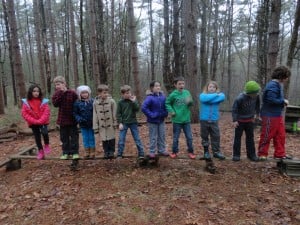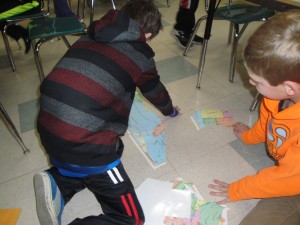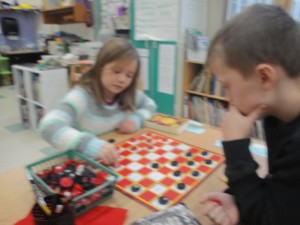3E wishes everyone a fun-filled holiday and an amazing vacation…
seriously…
with strength…
and joy!
See you in 2015!
 This week was full of excitement and energy, schoolwork and sharing. We have continued our fable reading and writing. Most of the children have completed a first draft and many are thinking of ways their morals can guide our every day lives. We are making a variety of painted papers to use in making collage illustrations for our fables and that is great fun. We had a challenge with Mr. Caron that took some creative problem solving and cooperation. And of course, there is the usual daily reading, writing, handwriting, math and social studies
This week was full of excitement and energy, schoolwork and sharing. We have continued our fable reading and writing. Most of the children have completed a first draft and many are thinking of ways their morals can guide our every day lives. We are making a variety of painted papers to use in making collage illustrations for our fables and that is great fun. We had a challenge with Mr. Caron that took some creative problem solving and cooperation. And of course, there is the usual daily reading, writing, handwriting, math and social studies
Celebration of Friendship
The most exciting part of our week happened yesterday. Thank you so much for supporting friendship in 3E. Our Secret Friend Celebration was a great success. The children had drawn their names randomly from a hat for this project and those combinations couldn’t have been better. Children had the opportunity to think about classmates in different ways. The thoughtfulness of the letters, poems and stories written for their classmates was touching. And the gifts friends had created for one another showed the care children had taken. I wish you could have heard each of them and seen the looks on their faces when they opened their gifts. Many of them fairly glowed.
The gifts were beautiful and so special! The expression on the faces of both the givers and the receivers were precious. I wish I could fully capture the joy and excitement of each of the children as they discovered who their secret friend had been. The light in each child’s eyes when his or her gift was opened was one of shear happiness and appreciation. Each friend was thrilled by the time and effort. The combined gifts were thoughtful and heartfelt. They are something to keep forever. We truly have a wonderful class of kind and caring friends.
Exploring Maps and Mapping
We have continued learning about continents, maps and the features of maps. Some of our classmates know a great deal about geography, while others have given “place” very little thought. We are completing a “me on the map” activity and thinking about the parts of the world we would be most interested in learning more about.
There are lots of words to think about and know when dealing with maps. It is interesting to consider the difference between county and country, continent and capital. We are learning about hemispheres and cardinal directions. We are trying to understand what we can see and where we could see it in our world.
Exploring Place Value With Kilograms
After making our kilogram weights last week, we have been considering how weight is measured and how different weights feel. We have been using pan scales and balances to explore these concepts further. The children have been making estimates and thinking about how much different things weigh. A kilogram – 1,000 grams – is surprising. It is small, but it is 1,000. The children are beginning to grasp that idea as we move into addition and subtraction of those weights and amounts.

Bits and Pieces –
 Now that we are delving into measurement and place value, don’t forget to keep practicing your facts!
Now that we are delving into measurement and place value, don’t forget to keep practicing your facts!
Ginger bought 3 loaves of bread. Each loaf had 28 slices of bread. How many slices of bread did she have altogether?
Tim had 6 boxes of ornaments. Each box had 14 ornaments in it. How many ornaments did Tim have to decorate his house altogether?
Ben made 5 cups of cocoa. He put 17 mini-marshmallows in each cup. How many marshmallows did Ben use altogether?
Nick made cookies. He baked 8 dozen with his family. He frosted half of them. How many cookies were plain and how many cookies were frosted?
We can certainly tell the holidays are coming – and yet despite the tired excitement, lots of things are going on in 3E. We have continued to read a variety of fables and many of the children have written first drafts of their own. We are reading about different places around the world and learning about mapping. We are extending our measurement unit to include metric weight and volume. And of course we are hoping for less rain and more opportunities for running around outside.
SEL – Learning From Stories
Here are a few of the morals the children have chosen to teach through their fables: Don’t be mean about what you have. Never give up on your dream. Never fight, just talk it out. Follow your dream. Think of others, not only yourself. The other morals in the list are just as poignant and the original fables they are being taught through are thoughtful. The writing shows effort to follow the fable format: short, mainly animal characters and a lesson. In addition, the writing shows attention to the elaboration strategies we are learning to use: description, dialogue, inner thinking and action. Our next step will be using the morals to actually guide our choices and behavior, and to help us consider others before we act.
We are looking forward to illustrating them with collages and turning them into short animations when we return in January.
Learning About the World
 This week we have read and wondered about how life is both different and the same on each continent. It has been surprising to the children that weather and water really affect how people live all over the world – monsoon floods in Asia, rivers through most major cities in Europe and deserts on all of the continents but Europe. (Surprise – they can be either cold or hot!) It makes sense, but is also surprising to learn there are large cities on most continents – even Africa. The final surprise was that every continent is diverse – none are the same from North to South, East to West.
This week we have read and wondered about how life is both different and the same on each continent. It has been surprising to the children that weather and water really affect how people live all over the world – monsoon floods in Asia, rivers through most major cities in Europe and deserts on all of the continents but Europe. (Surprise – they can be either cold or hot!) It makes sense, but is also surprising to learn there are large cities on most continents – even Africa. The final surprise was that every continent is diverse – none are the same from North to South, East to West.
We also read books helping us think about all the things that are the same for people no matter how different they are – celebrations, families, favorite foods, pets and games to play. We look forward to learning even about more about our world.
There Are Many Ways to Measure
The children understand more about how time passes. They are better at solving time elapse problems. Problems like Timmy went skiing at 10:00. It took him seven minutes to ski down a blue trail. He skied doe that trail five times. What time was it when he finished his fifth run down the mountain? are much clearer now. Even problems like Nick was riding his bike. It took him six minutes to ride to the end of his driveway and back. He rode the loop six times and then went into his house. The clock read 3:50. What time was it when he started riding? are easier to solve. We’ll continue to work more with time but we can tell from comments and conversation in the classroom that telling time and keeping track of time are familiar – though not always easy – now.
We have created some kilogram weights with ziploc bags, rice and beans. We discovered how many groups of a hundred grams there were in a kilogram, as well as tens and singles. We are comparing this model with the place value model of thousands, hundreds, tens and ones and working with addition and subtraction. Our eventual goal is to gain comfort with the standard algorithm, trading and regrouping.
Bits and Pieces –

 bring their own lunches if they don’t care for pizza.)
bring their own lunches if they don’t care for pizza.) Marianna started reading her book at 3:35. She read for 20 minutes, then she took 10 minutes for a snack and went back to reading for 10 more minutes. What time was it when Marianna finished reading?
Marianna started reading her book at 3:35. She read for 20 minutes, then she took 10 minutes for a snack and went back to reading for 10 more minutes. What time was it when Marianna finished reading?
Ronan started working on his play at 1:25. He worked 6 minutes on putting his puppets together. He worked for 15 minutes on making the scene. He worked for 5 minutes on planning what the puppets would say. What time was it when Ronan finished?
Stella finished her first tennis match at 9:22. The match was 25 minutes long. When did Stella begin her match?
Alexis’ soccer game ended at 7:30. She played for 70 minutes. What time did her soccer game begin?
 Thank you for taking the time to meet with me for our parent teacher conferences. I find myself short on time this week and so am sending home a list of things we have accomplished. Hopefully you’ll have the opportunity to talk to your child about what’s here and he or she can add in more information and details.
Thank you for taking the time to meet with me for our parent teacher conferences. I find myself short on time this week and so am sending home a list of things we have accomplished. Hopefully you’ll have the opportunity to talk to your child about what’s here and he or she can add in more information and details.
Here are some of the things we’ve been doing:
Math
Reading and Writing
 Oliver read his book for 24 minutes on Monday and for 32 minutes on Tuesday. How many minutes did Oliver read altogether? How many more minutes would he need to read if his goal was to read from 1 hour and 30 minutes for the week?
Oliver read his book for 24 minutes on Monday and for 32 minutes on Tuesday. How many minutes did Oliver read altogether? How many more minutes would he need to read if his goal was to read from 1 hour and 30 minutes for the week?
If Oliver started reading at 3:35 on Monday, what time would it be when he finished reading that day?
Alexis spent 36 minutes washing Ethan. It took her 12 minutes to shampoo and rinse him. Alexis used the rest of the time to get him into the tub. How many minutes did it take Alexis to get Ethan into the tub?
Alexis walks her dog for 32 minutes. Nick walks his dog for 47 minutes. How many more minutes does Nick walk his dog than Alexis?
If Nick begins walking his dog at 7:45, what time will it be when he has finished walking his dog?
 Fifteen turkeys were eating acorns on my front yard. Each turkey ate 6 acorns every hour. They came to my yard started eating at3:15. They left the yard at 6:15. How many acorns did the turkeys eat altogether?
Fifteen turkeys were eating acorns on my front yard. Each turkey ate 6 acorns every hour. They came to my yard started eating at3:15. They left the yard at 6:15. How many acorns did the turkeys eat altogether?
Five of the turkeys were small. They each had 24 tail feathers.
Five of the turkeys were medium. They each had 30 tail feathers.
Five of the turkeys were large. They each had 36 tail feathers.
How many tail feathers did the turkeys have altogether?
The turkeys each took five minutes to leave the yard and fly up into the tree they roost in for the night (yes, wild turkeys fly and yes, wild turkeys roost in trees at night to keep safe). The first of the fifteen turkeys began flying to the roost at 6:15. What time was it when the final turkey flew into the tree to roost?
I hope you Thanksgiving and holiday break are terrific!
Thank you so much for finding time to meet with your child so she or he could share work from the first third of our school year and goals they have set to guide learning for the remainder of 3rd grade. One of the main pillars of our Social Emotional Learning curriculum is centered on self-awareness. The children each spent a portion of time thinking about their multiple intelligences and how they are smart. They reflected on strengths and challenges and selected work samples to show current abilities and understanding. This process of self-reflection shows how clearly the children are able to see themselves. We hope seeing the chosen work, hearing the work habit descriptions and knowing the goals set for the up-coming terms will help you better understand the report card sent to you next Tuesday.
We will use these student presentations to ground our conversation at parent teacher conferences in the first week of December. Please find the enclosed conference sign-up and descriptive information to help you understand how our standards-based report cards work. Your children are self-aware. They know strengths and challenges and have set reasonable and attainable goals that will promote learning. They deserve to feel proud of their efforts and their ability to present themselves to you. It is not an easy task.
Celebrating Science
On Monday the three classrooms of scientists joined together to share their Who Am I? projects. They sought out scientist partners and shared the artifacts they had chosen to illustrate the work of their scientist. It was interesting to see the similarities and the differences and an exciting way to gain recognition of how science surrounds us in so many different ways.
On Tuesday our celebration continued with our trip to the S.E.E. Science Center at the Amoskeag Mills. Highlights for the class were making silly putty to see how states of matter change in a chemical reaction, learning about static electricity, conduction and insulation with the Van de Graaf generator, and gravity combined with forces of motion at the harmonograph. There were also opportunities to explore light and shadow, symmetry and reflection, ramps and velocity, magnetism and simple machines. I think it is safe to say that we have a class full of students who are excited about science and discovery. They are very interested in the world and how it works.
Informational Writing
Over the past month the children have been researching a science topic of their choice. They have been learning about tornadoes and lightning, the Sun and Jupiter, fish, sperm whales and dolphins. Others have been exploring prehistoric animals, turkey vultures, service dogs and insect eyes.
While the children researched, the class modeled the process together in learning about trees. We read many different books, looked at different articles and websites to explore the importance to trees. We explored the question – Does cutting down one tree matter? – and divided into groups to share our argument and to support our opinion with the facts and information we had gathered.
We used familiar texts shared with the class, to identify three different formats (there are more, but we are beginning here) for organizing information. They are descriptive, compare/contrast and sequential. Each of these formats has an associated graphic organizer. The children are working to organize their researched information in his/her chosen way to discover an original way to present it. At this point their work is allowing them to see holes in their understanding and is prompting them to develop further questions to guide another round of information gathering before they share their what they have learned with you and each other.
Bits and Pieces
 The gray squirrels were collecting acorns for winter. Three of them had collected 125 acorns. Two had collected 76 acorns. How many acorns had the five squirrels collected altogether?
The gray squirrels were collecting acorns for winter. Three of them had collected 125 acorns. Two had collected 76 acorns. How many acorns had the five squirrels collected altogether?
Some red squirrels were eating the seed out of pinecones. There were 4 pinecones. Each cone had 48 seeds. How many seeds did the squirrels get to eat altogether?
Squirrels have really great balance. They can run and jump from tree to tree quickly. It took 5 seconds for a squirrel to leap from one tree to the next. If the squirrel traveled across 24 trees, how many seconds would it take the squirrel to make that trip? How many minutes and seconds would that be?
If the squirrel started its trip at 8:32, what time would it ben when it was finished?